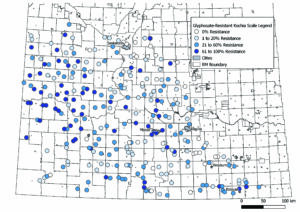Widespread triple resistance in kochia
KEY RESULT:
Farmers need an integrated approach to stop kochia. Take steps to deplete seedbanks, use cultural methods to rapidly achieve crop canopy closure, and apply a tank mix of pre-seed herbicides.
PROJECT TITLE, PRINCIPAL INVESTIGATOR:
“Glyphosate- or auxinic-resistant kochia and Russian thistle Prairie surveys,” Shaun Sharpe, Agriculture and Agri-Food Canada Saskatoon
FUNDING:
SaskCanola, Alberta Wheat, Manitoba Pulse & Soybean Growers, Manitoba Crops Alliance, SaskPulse, SaskWheat, Western Grains Research Foundation
PUBLISHED ARTICLES:
Read the full report on the Canola Research Hub.
For practical tips to reduce the seedbank, read “Integrated weed management:
Best practices” in the Weeds section.
Kochia infests agricultural and disturbed areas on the Prairies, spreading thousands of seeds per mature plant as it tumbles across the landscape. The weed has become harder to kill with herbicides.
Kochia has evolved resistance to several modes of action, including ALS-inhibiting herbicides (Group 2), glyphosate (Group 9), and synthetic auxins (Group 4). The study objective was to survey glyphosate-resistant and dicamba-resistant kochia distributions in Manitoba, Saskatchewan and Alberta.
Researchers conducted randomized surveys post-harvest, starting in early October. They surveyed Manitoba in 2018, Saskatchewan in 2019 and Alberta in 2021. Researchers planted seeds from each sample and applied discriminating doses of glyphosate (900 grams of acid equivalent per hectare) or dicamba (280 grams of acid equivalent per hectare) to test
for resistance.
Results
The incidence of glyphosate-resistant kochia increased substantially from previous surveys. Researchers found glyphosate resistance in 58 per cent of Manitoba samples, 87 per cent of Saskatchewan samples and 78 per cent of Alberta samples. They found dicamba resistance in on per cent of Manitoba sites, 45 per cent of Saskatchewan sites and 28 per cent of Alberta sites. This documents the first instance of dicamba-resistant kochia in Manitoba.
Assuming all kochia is resistant to ALS-inhibitors, triple-resistant kochia was present in 40 per cent of Saskatchewan samples (n=255), less than one per cent of Manitoba samples (n=300), and 10 per cent (n=314) of Alberta samples. Additional screening showed 44 per cent of Alberta samples were fluroxypyr-resistant and 25 per cent were triple-resistant.
Herbicide-resistant kochia has become more prevalent on the Prairies. Seedbanks should be depleted to reduce selection pressure on herbicides. Cultural methods to rapidly achieve canopy closure should be integrated with pre-emergence herbicides to prevent escapes after herbicide efficacy wanes. Kochia is present in many environments outside of cropped land so mitigation procedures for tumbleweeds are advised.

Glyphosate-resistant kochia within Saskatchewan in 2019. Resistance is expressed as low (one to 20 per cent), moderate (21 to 60 per cent), and high (61 to 100 per cent) which corresponds to the percentage of resistant plants within each population.





